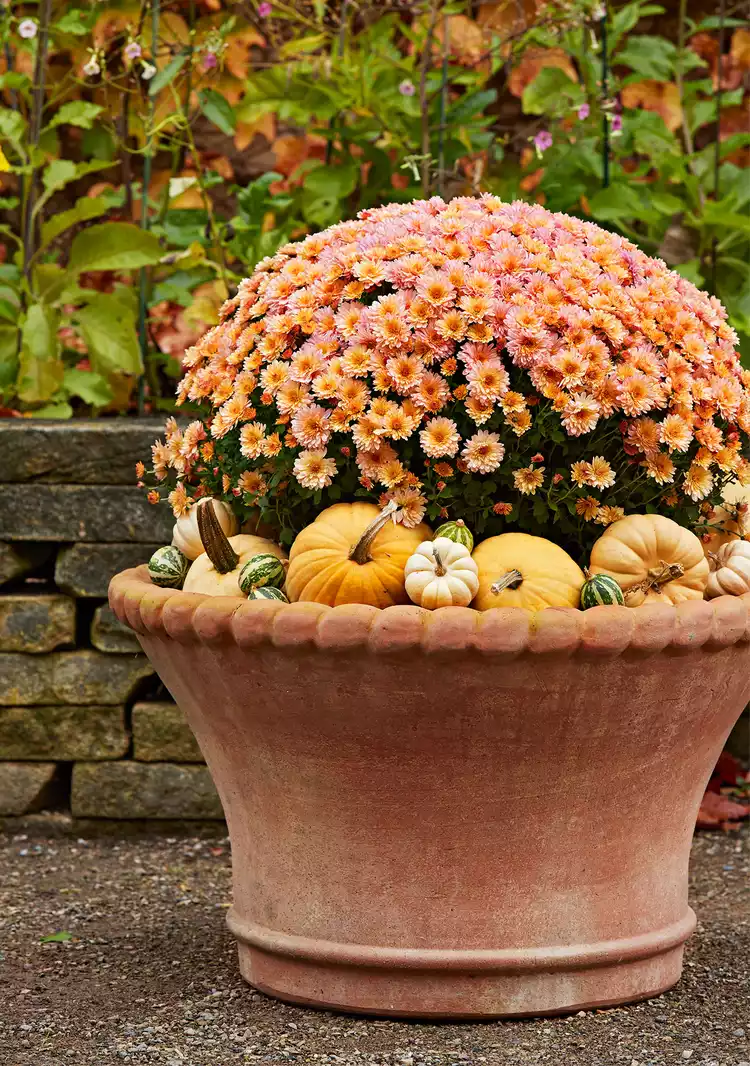After putting oodles of time and money into planting mums in pots, it's only natural to want their colorful flowers to last as long as possible. Once you know how long mums in your region remain in bloom, you can plan according to your hardiness zone and buy your potted plants at the right time of year to get the most out of their bloom time. Here are some key factors that affect how long mums last, along with five tips to help you take care of potted mums so they keep blooming.
How Long Mums Last
Even though mums are available for purchase well before fall begins, these plants thrive in cooler temperatures. If you're planting mums in pots, don't set them out when the temperature is still warm, or the flowers will fade in a few weeks. Waiting to buy your mums until it's cooler will help them last longer, so you can enjoy their beautiful blooms for up to eight weeks before frost.
How to Care for Mums in Pots
Help your potted mums last as long as they can with this list of tips.
1. Choose the Best Mums
Success starts with choosing the best chrysanthemums for your fall containers. Although just about every supermarket and big box store will offer mums during the fall, it pays to shop carefully. These plants often get under or overwatered, which stresses them, so they won't perform as well for you.
For best results, ask when a store is getting a new shipment in and go first thing that day to get the cream of the crop. Or visit your local garden center or nursery, which will often have a more extensive selection, and the plants will usually be better cared for and healthier. Wherever you shop, avoid buying a wilted plant and look for ones with more buds than open flowers; when planting mums in pots, you'll get more bloom time out of them, and they'll likely survive repotting better.
2. Pay Attention to the Types of Mums
Take a glance at the plant's label to check the type of mum and its bloom time. You may find both florist mums and garden mums available for fall decorating.
Florist Mums: If you're looking to decorate your front porch for just a few weeks before the frost hits, then buy florist mums (also known as cutting mums)—these gorgeous annuals are used as short-term bedding plants, but don't expect them to survive the winter outside, no matter how you protect your plants from winter weather. Florist mums don't produce many underground runners needed to survive cold weather. This mum won't carry on once the blooms die or frost arrives.
Garden Mums: If you want a more permanent perennial, plant a garden mum (hardy mums). These perennials can survive a light fall frost better than florist types and are an excellent option for planting mums in pots. To improve their chances of overwintering and reblooming the following year, plant these mums in the spring after the last frost date in your region to allow their roots to get established in the garden.
Better Homes & Gardens Red Mum in Decorative Pot ($36, Walmart)
3. Repot Right Away
Always repot a purchased potted mum plant when you get it home. They're usually root-bound, meaning the roots take up most of the pot. Replant the mums in a container larger than they came in so the roots can spread out and breathe. Gently loosen tangled roots before repotting to encourage them to grow outward again.
These plants do best in well-drained soil, so use a potting mix when planting mums in pots. If you are growing mums in pots for a single season, you can mix them with other plants in a large container. If you want to try overwintering your potted mums, plant them by themselves in a container that's easy to move indoors when freezing temperatures arrive.
4. Give Potted Mums Enough Sunlight
Mums need at least six hours of sunlight each day. If you live in a warmer gardening zone, plant your potted mums in a shaded area to prevent the sun from scorching the plants. And if your daytime temperatures are still getting up into the 80s and beyond, protect your plants from the harsh afternoon sun to help the flowers last longer.
5. Water Potted Mums Well
Chrysanthemums won’t last long without water, so whenever the soil feels dry, water your plants. Never let your potted mums wilt. If you notice that the bottom leaves look limp or start to turn brown, water more often. When watering your mums, try not to splash the foliage to avoid plant diseases.
What to Do with Potted Mums After Blooming
Before freezing weather occurs, give the mums you hope to overwinter a bit of liquid fertilizer higher in phosphorus to stimulate root growth. Then, once the first hard frost hits, move your plants inside or into an unheated garage. Pinch off dead blooms to clean up the plant, but leave branches intact; mums have a better chance of surviving if you wait until spring to prune old stems.
Add up to 4 inches of straw or shredded hardwood mulch on top of the soil, filling in around the entire plant and spreading well between branches. Then, cover the pot with burlap or an old sheet. As soon as spring weather warms up, pull away mulch to allow new shoots to pop up and move your pots outside into the sunshine.




















